Step into the captivating world of the prickly pear cactus group. This is an extraordinary collection of cacti. Prickly pears (They reside in the Opuntia genus in the Cactaceae plant family) are showstoppers in outdoor gardens and landscapes. And certain species of prickly pears are fun to grow indoors.
Prickly pear cacti, have a stark structural beauty with bold form and stunningly bright flowers. These resilient, versatile plants are known for their flat, two dimensional fleshy pads. Different varieties of prickly pairs grow pads in either an elongate, oval or paddle-shape. Some species are spiky and some are spineless. But they are always at least somewhat prickly due to small hair-like prickles called glochids.
Prickly pear cactus come in a variety of colors. The paddles can be green, blue-green, or purple. Optunia also produce vibrant flowers in shades of yellow, orange, pink, or red, which develop into edible fruits and are used in many recipes, once properly prepared.
If you can grow a prickly pear cactus, you should give it a try. They have a LOT to offer the home gardener.
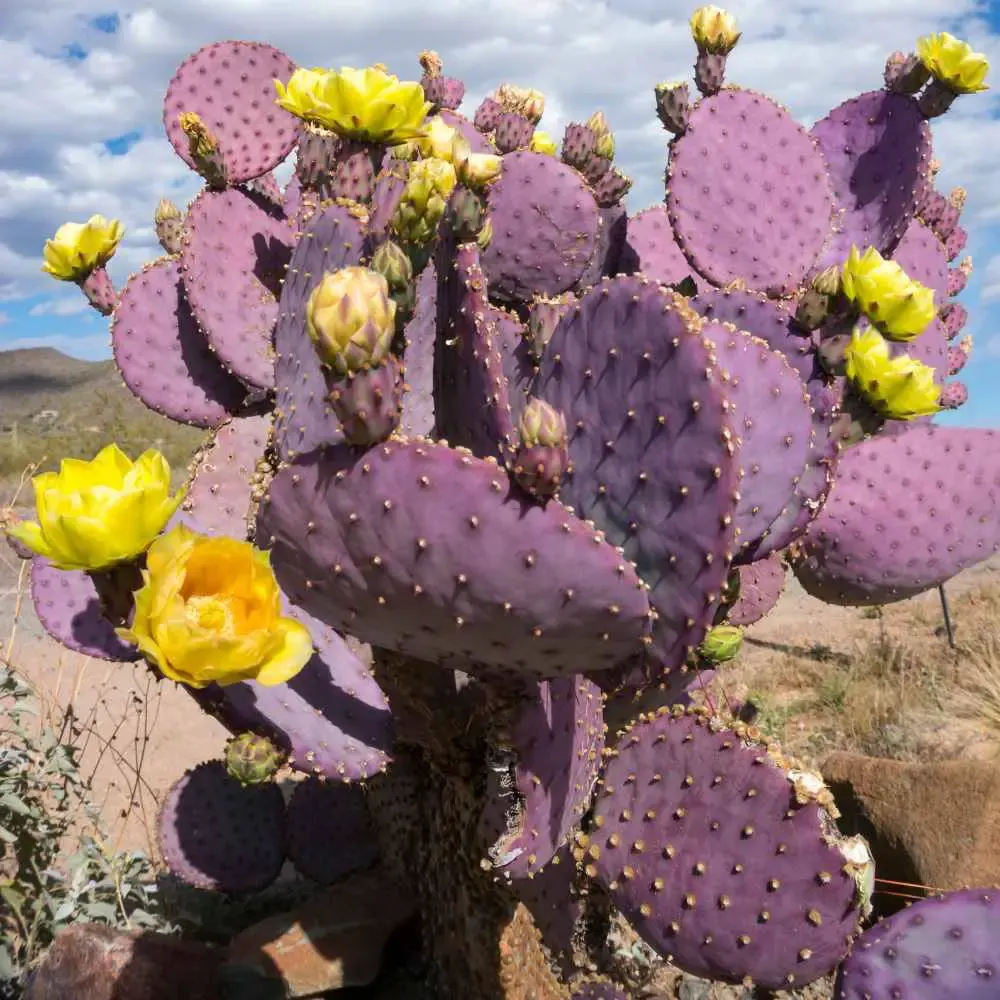
Prickly pear cacti of the various species within the Optunia genus have diverse growth habits. Some species grow low to the ground, forming dense mats or spreading clumps. Others grow more upright, developing tree-like structures with a central trunk and branching arms.
The prickly pear cactus, as a group have a striking appearance, diverse growth habits, and unique adaptations. They are also culturally and ecologically important to certain regions. They are a fascinating addition to arid and desert landscapes. Some will grow well indoors as well.
Growing Prickly Pear Cacti Outdoors:
Prickly pear cacti are well suited to zones with mild to hot temperatures. Here are some general guidelines:
Prickly pear cacti grow well outdoors in USDA hardiness zones 9 to 11. In these regions, growing prickly pear cacti can be practical and low-maintenance. These zones include southern parts of the United States, such as southern Florida, southern Texas, and parts of Arizona and California.
Some varieties of obtunia will do well down to zone 8 with occasional freezing temperatures. But sustained or deep freezing temperatures will require some extra care to keep the prickly pear alive and in decent condition through the winter months.
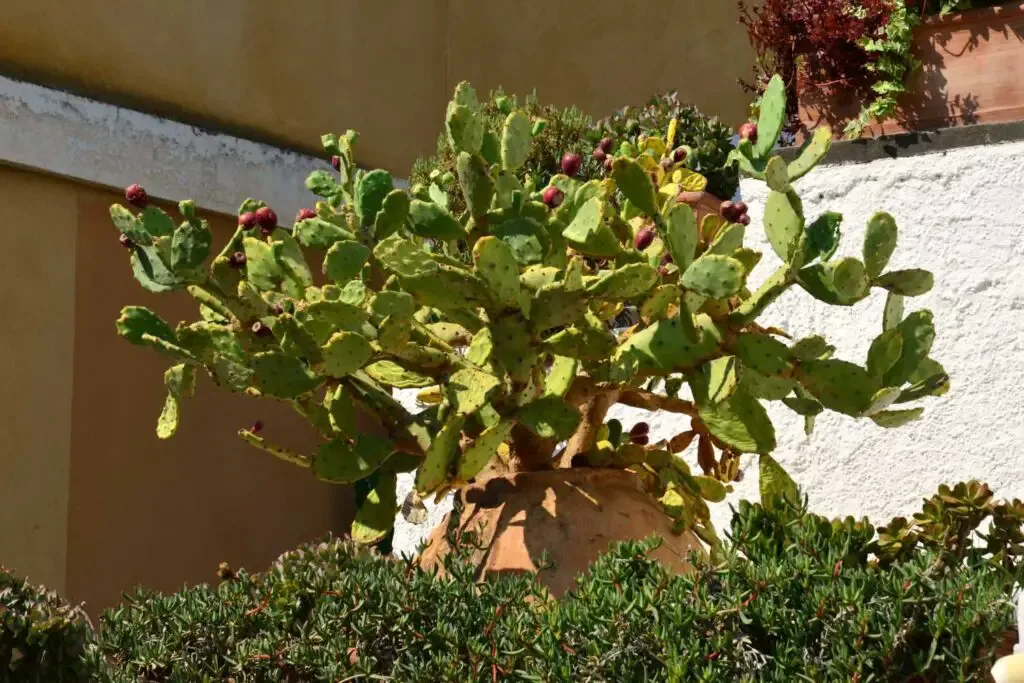
Uses For Prickly Pears in the home Garden:
Add unique visual interest and texture to your yard by adding prickly pear cactus. Their flat, two dimensional look and brilliant flowers add interest and beauty to arid landscapes. Here’s some ideas on how to use them.
- Centerpiece or focal point Plant: Planting a mature spiky prickly pear cactus as a centerpiece in a xeriscape garden can create a striking focal point. Its spiny pads and architectural form can add a bold and dramatic element to the landscape.
- Vertical Gardens: Spiky prickly pear cacti can be incorporated into vertical gardens or living walls, especially in indoor settings. Their upright growth habit and interesting spines make them visually appealing when planted alongside other succulents or drought-tolerant plants on a vertical structure.
- Container Gardening: Grow spiky prickly pear cacti in containers to create a captivating display on patios, balconies, or indoor spaces. Choose decorative pots that complement the cactus’s unique features. Group different-sized cacti together to create a visually dynamic arrangement.
- Textured Borders: Use spiky prickly pear cacti to create borders or hedges in xeriscape gardens. Their spiny pads can act as natural deterrents, adding a layer of security along with aesthetic appeal. Ensure proper spacing between plants to accommodate their growth and avoid overcrowding.
- Rock Gardens: Combine spiky prickly pear cacti with rocks, boulders, and other desert-adapted plants to create a natural-looking rock garden. The contrast between the cacti’s spines and the rugged texture of the rocks can enhance the overall design and evoke a desert-like ambiance.
- Accent Plants: Place spiky prickly pear strategically throughout the garden to serve as accent plants. Their unique appearance and architectural form and bright flowers will draw attention and add a touch of desert beauty to specific areas or corners.
Both Spiky and spineless varieties of prickly pear cacti provide interesting, eye-catching focal points in xeriscapes or arid outdoor gardens.
Here’s a table listing some varieties of prickly pear cacti you will often find in your local garden shops. We’ve separated them into spineless and prickly varieties for you. Look for the species that best suit your needs.
| Spineless Varieties | Prickly Varieties |
|---|---|
| Opuntia ficus-indica | Opuntia engelmannii |
| Opuntia ellisiana | Opuntia phaeacantha |
| Opuntia monacantha | Opuntia macrocentra |
| Opuntia santa-rita | Opuntia compressa |
| Opuntia microdasys | Opuntia basilaris |
| Opuntia humifusa | Opuntia lindheimeri |
| Opuntia aurea | Opuntia stricta |
| Opuntia bergeriana | Opuntia violacea |
| Opuntia cochenillifera | Opuntia polyacantha |
| Opuntia leucotricha | Opuntia gosseliniana |
This is not an exhaustive list. There are many more varieties of prickly pears available. The selection may vary depending on your region and local nurseries or suppliers. But this is a good start if you want to look up and learn about specific species of prickly pears that might work best for you.
Prickly Pear for Sustainable Landscape and Erosion Control:
Prickly pear cactus offers a host of environmental benefits when incorporated into landscaping, making them a valuable addition to your home garden.
- Thriving in Arid Conditions: Prickly pear cacti are well-adapted to arid climates and can withstand prolonged periods of drought. Their ability to store water in their fleshy pads allows them to survive in regions with limited rainfall. By incorporating prickly pear cacti into landscaping, water resources can be conserved as these plants require minimal irrigation once established.
- Erosion Control: Prickly pear cacti play a crucial role in preventing soil erosion, particularly on slopes. Their deep root systems anchor the soil and provide stability, reducing the risk of erosion caused by wind or water. Additionally, the spreading habits of some prickly pear varieties form dense mats, further aiding in erosion control by holding the soil in place.
- Xeriscaping and Water Conservation: Prickly pear cacti are often embraced in xeriscaping, a landscaping approach focused on water conservation and minimizing irrigation needs. These cacti thrive in low-water conditions, reducing the reliance on traditional watering methods. By incorporating prickly pear cacti into xeriscape designs, homeowners and landscapers can create beautiful, low-maintenance gardens that minimize water consumption.
- Habitat Creation: Prickly pear cacti provide habitat and food sources for various wildlife, including birds, insects, and small mammals. The dense pads and fruits of the cacti offer shelter, nesting sites, and nourishment for these creatures, contributing to biodiversity and ecological balance in the landscape.
By planting prickly pear cacti into our landscaping, we embrace their resilience in arid conditions, harness their erosion control abilities, and promote water conservation through xeriscaping. These environmental benefits make prickly pear cacti an excellent choice for sustainable and low-maintenance gardens, allowing us to harmoniously integrate nature into our outdoor spaces while minimizing resource consumption. However, these attributes can also be a problem. Read on…
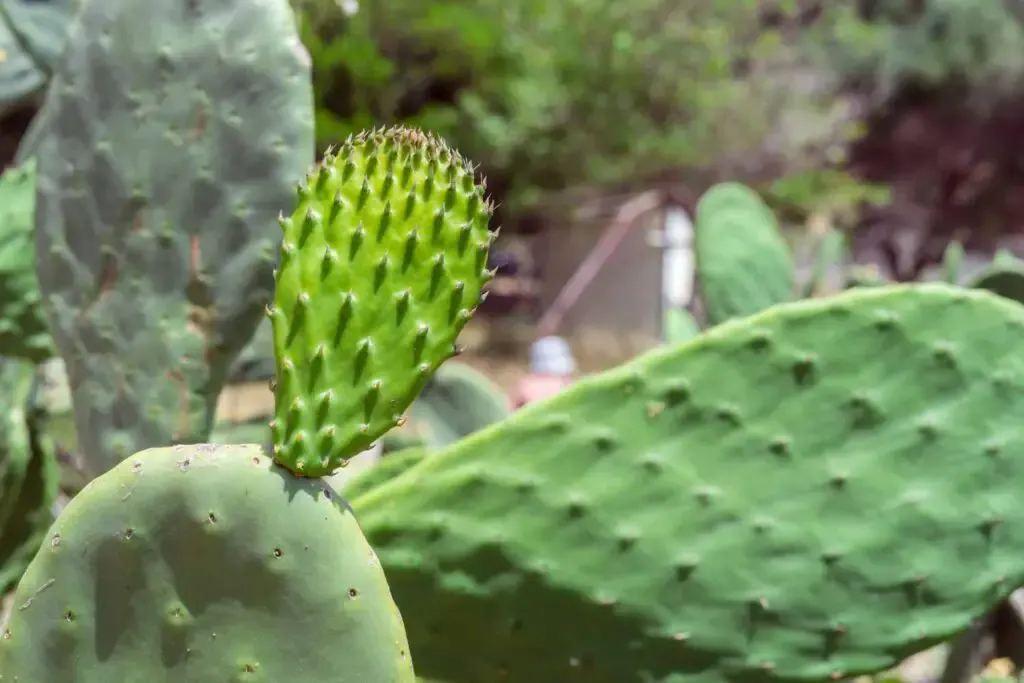
Invasive Species Warning:
Prickly pear cactus (Opuntia spp.) are easy to grow and do well in lots of conditions. Prickly pear cacti have evolved several adaptations to survive in arid environments. Their fleshy pads store water, allowing them to endure drought conditions. The spines help reduce water loss and provide protection against herbivores.
This ability to thrive in many areas gives prickly pears invasive tendencies. These cacti are native to parts of the Americas. But they have been introduced and cultivated in various locations worldwide. When conditions are favorable certain species of prickly pear can spread rapidly and become invasive.
They are known to form dense colonies and compete with native plant species, which can negatively impact biodiversity and ecosystem balance.
Research and select native or non-invasive species and cultivars when incorporating prickly pear cactus into landscaping or gardening projects. Regularly monitor and control the spread of these cacti if they get out of hand do pruning, removal of seedlings, or create physical barriers that can help prevent the spread of invasive populations and protect native ecosystems. if all else fails, remove them from your yard and plant them indoor s or containers only.

Specifically, In the United States, some areas where prickly pear cactus can become invasive include:
- Southwest United States: Prickly pear cactus is native to many parts of the Southwest, including Arizona, New Mexico, and Texas. In these regions, certain species, such as Opuntia engelmannii and Opuntia stricta, have been known to naturalize and spread beyond their native habitats.
- Hawaii: Prickly pear cactus has become invasive in certain parts of Hawaii, particularly on the islands of Maui and Hawaii. The lack of natural predators and suitable climate have contributed to their rapid spread in these regions.
- California: Several species of prickly pear cactus have naturalized and become invasive in parts of California, including the coastal areas and the southern desert regions. Opuntia ficus-indica and Opuntia littoralis are examples of species that have shown invasive behavior in California.
Bottom line: Be careful where you plant them. Don’t let them get out of hand. Invasive species crowd out other beneficial plants and create mono cultures that actually inhibit bio diversity and sustainability.

Growing Obtunias Indoors:
Growing prickly pear cacti indoors can offer dramatic structural beauty and colorful accents of color to your home decor.
How to Select your optunia cactus. Choose prickly pear cacti varieties that have fewer spines or even spineless pads for the home. Choosing the correct varieties for your circumstances minimizes the risk of injury indoors.
Think smaller Size:
Prickly pear cacti exhibit a wide range of size variations. The larger prickly pears can attain over 20 feet high and look like trees with a cactus top. Some varieties are more suitable as houseplants due to their compact growth habits. When selecting a prickly pear cactus for indoor use, consider your available space and the cactus’s growth habit. Remember, regular pruning and maintenance can help control the size and shape of the plant to some degree.
Here are a few prickly pear cactus varieties that are generally smaller in size and are considered good houseplants:
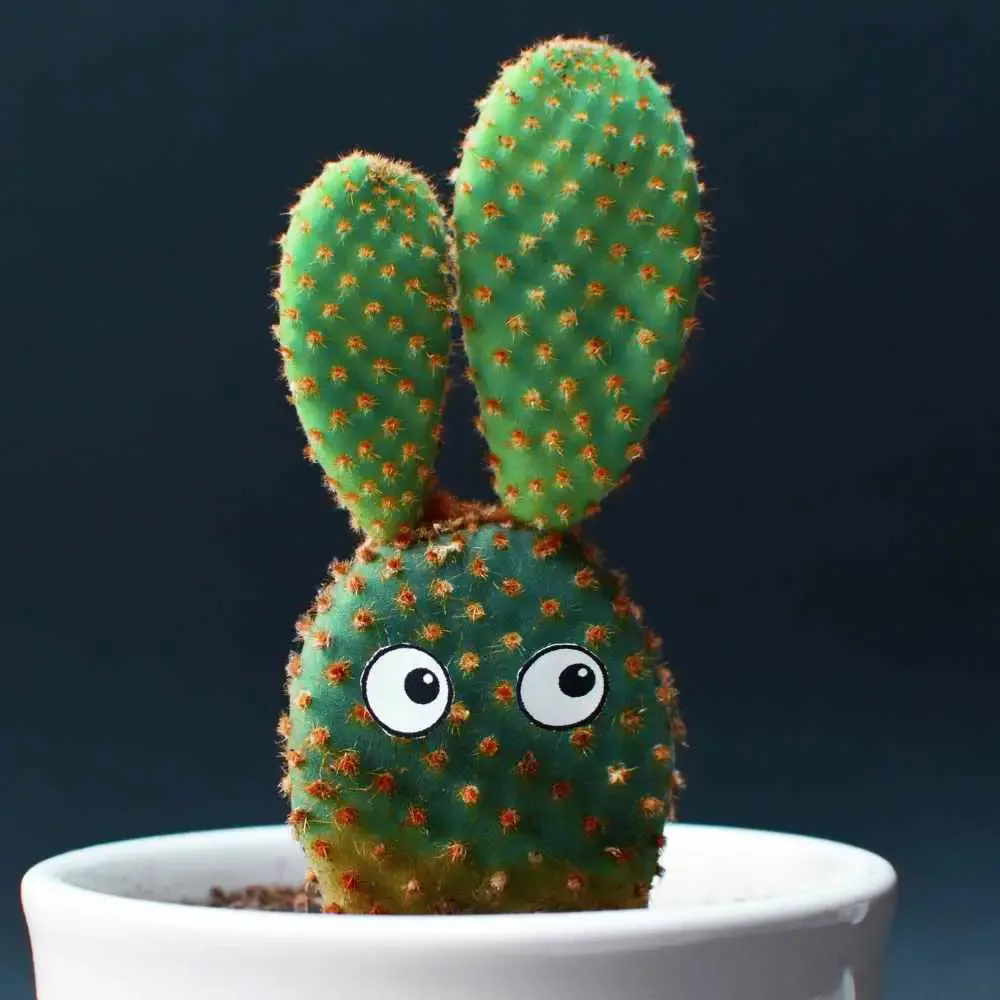
- Opuntia microdasys: Also known as the Bunny Ear cactus, this variety typically stays relatively small, growing 1 to 2 feet tall and wide. This makes it an excellent choice for growing indoors. It features distinct pads covered in soft, fuzzy spines that resemble bunny ears.
- Opuntia monacantha: This variety, commonly called the Drooping Prickly Pear, has flattened pads with noticeable spines. While it can grow larger if provided ample space, it can be pruned and maintained as a smaller indoor specimen.
- Opuntia rufida Minima Montrose : The is a charming variety of optunia with diminutive cylindrical stems that grow to only 10 inches tall. It’s covered in short spines. It tends to stay compact and can be a delightful addition to your indoor collection.
- Opuntia polyacantha: This species includes several subspecies and varieties that exhibit a range of sizes. Some forms, such as Opuntia polyacantha ‘Pincushion’, have smaller pads and a clumping growth habit, making them suitable for indoor cultivation.
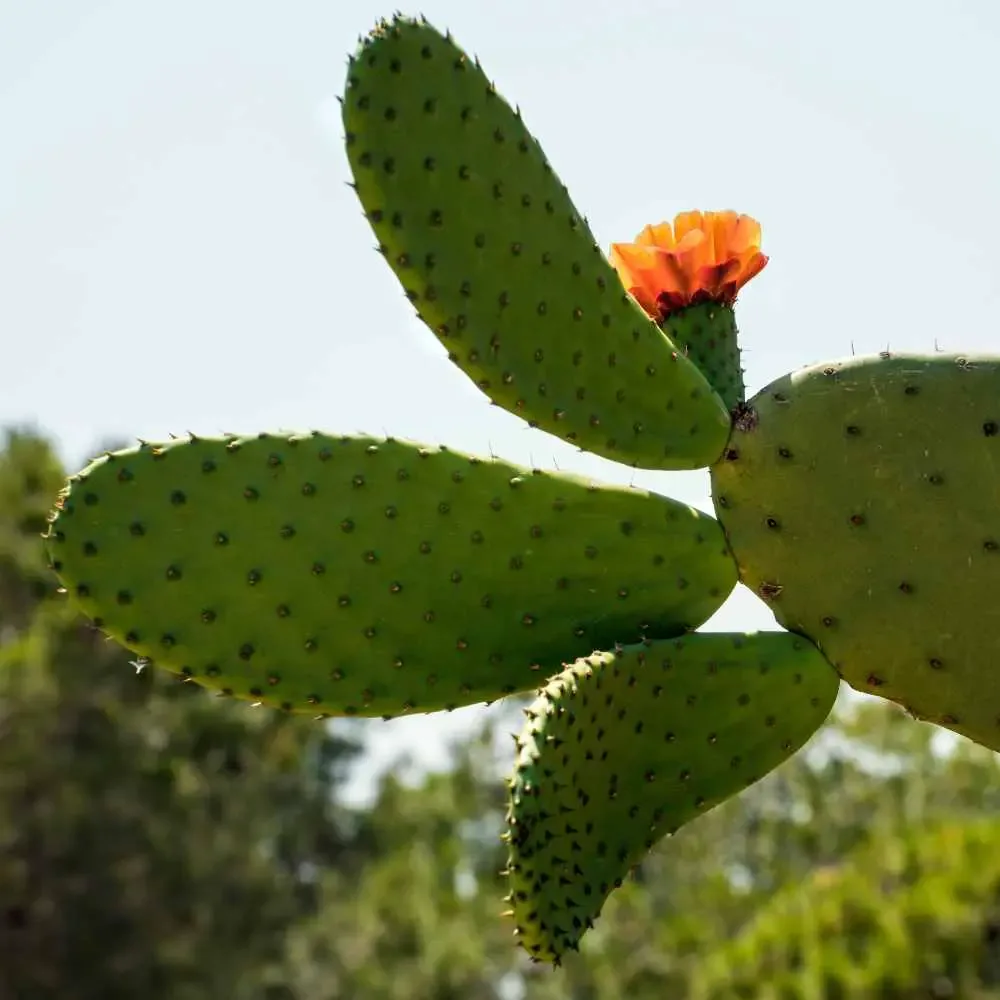
Safety: Various Prickly pear cacti have sharp spines and hurt when touched or accidentally brushed against.
Lighting: Prickly pears need sufficient space and access to bright sunlight to thrive indoors. Ensure that you have a suitable location with adequate light conditions. You may supplement with artificial lighting if needed.
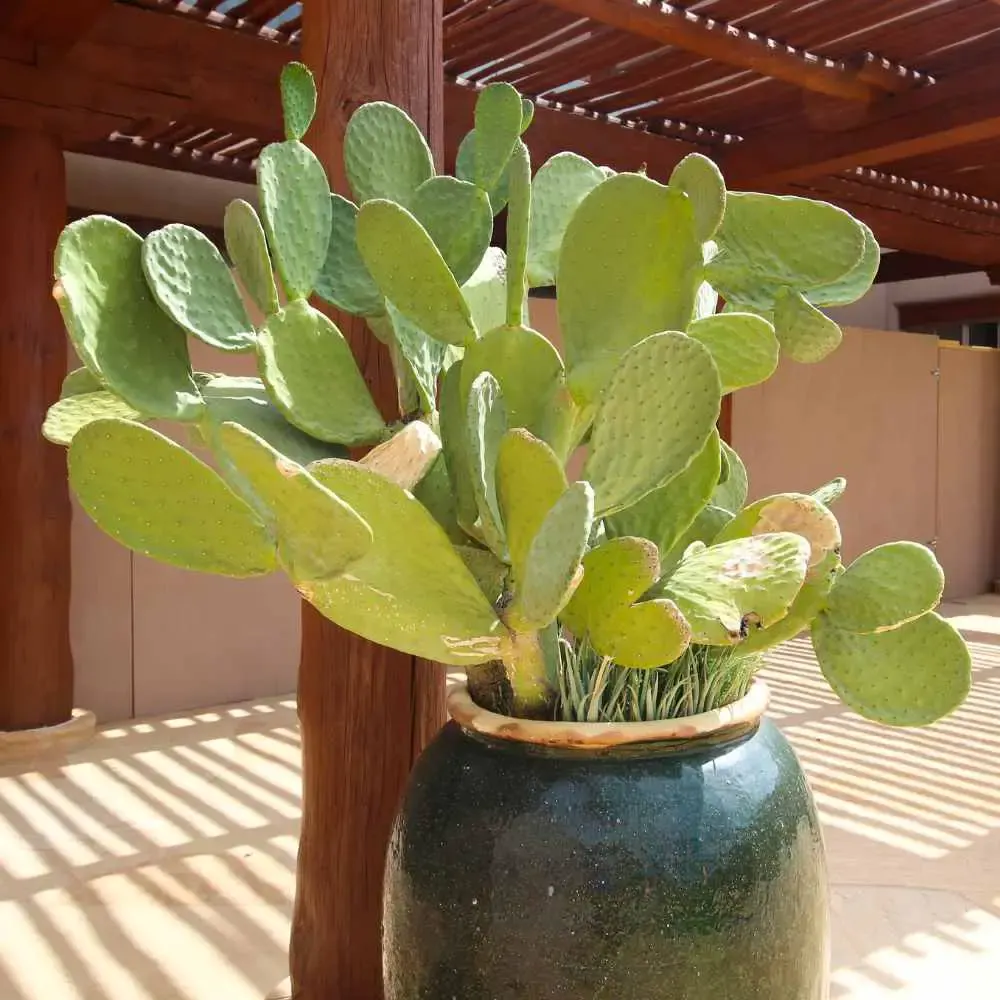
Kids, Pets and Cacti:
Place cacti in a location that is out of reach of children and pets if possible. Use protective barriers, such as fences or shelves, if necessary, to prevent accidental contact. Educate children about the potential risks and teach them not to touch or handle all cacti.
Spineless varieties of prickly pear cacti are safer around young children and curious pets compared to varieties with spines. However, even glochids (tiny hair-like prickles) can embed themselves in skin and cause pain and irritations.
If spines do get embedded, tweezers or tape can be used to remove them. Seek medical help if the penetrations get irritated or infected.
Non-Toxic: Fortunately prickly pear cacti are non-toxic to pets and people. However, sensitivities and reactions can vary to cacti. Some people or pets may experience mild irritation or allergic reactions upon contact with glochids or cactus sap. Always closely supervise interactions between young children or pets and any type of prickly pear cactus, including spineless varieties.
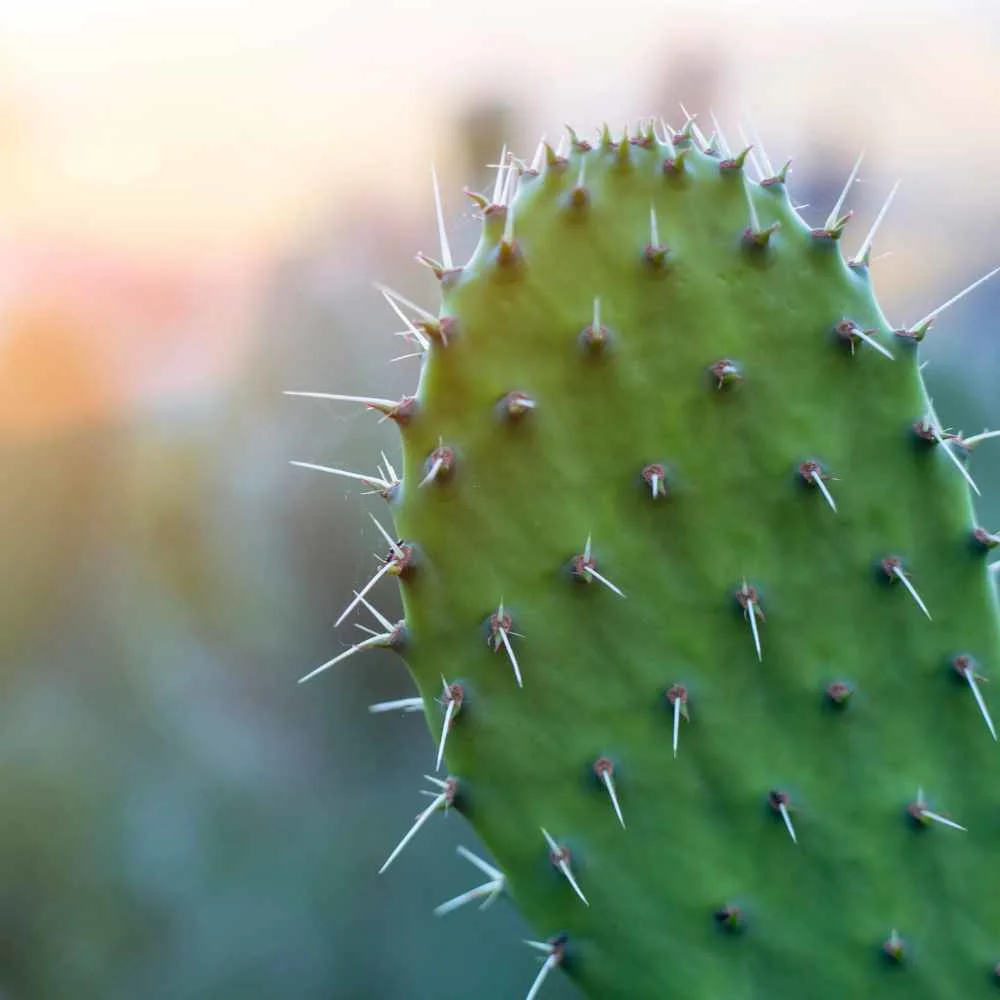
Grow Prickly Pears For Food:
Is prickly pear cactus safe to eat? Yes, in fact, prickly pear cactus have a long, strong traditional and cultural food connection in Mexico and the southwest. Many people enjoy growing certain varieties of prickly pear as a food source. The most common culinary species is the Indian fig opuntia (O. ficus-indica). The Indian fig gets very tall (Up to 16 feet high) so it may be a good candidate for a very large open area of the home, or in your garden.
Prickly pear cactus are highly nutritious, delicious and versatile in their culinary uses. Try a Prickly pear Margarita! You can make it with your own homemade Prickly pear syrup from cacti you grow yourself. SO many other ways to enjoy this delicious food.
Edible Parts: The pads, known as nopales, are commonly consumed as a vegetable and are rich in fiber, vitamins, and minerals. The fruits, called prickly pears or cactus figs, are sweet and juicy, and can be eaten fresh or used in various culinary preparations.
Glochid Removal from Pads or Fruits:
- Before using or consuming prickly pear pads or fruits, it’s essential to remove the glochids.
- To remove glochids from pads, gently scrape the surface with a sharp knife or vegetable peeler to remove the glochid clusters.
- For fruits, wear gloves and use tongs to hold them. Burn off the glochids over a flame (e.g., a gas stove) or use a brush or comb to remove them.
Once the pads are harvested and prepared they can be enjoyed in a myriad of dishes.
Prickly Pear Cactus as Medicinal Plants:
The prickly pear cactus spiky exterior hides a treasure trove of potential medicinal uses. The Opuntia cactus group, has long been recognized in traditional and alternative medicine for its health benefits and therapeutic properties. From its succulent pads to its vibrant fruits, this remarkable plant offers a range of potential health-boosting compounds.
One of the key health benefits associated with consuming prickly pear cactus is its rich antioxidant content. Antioxidants help combat harmful free radicals in the body, protecting cells from damage and promoting overall well-being. Additionally, prickly pear cactus has shown potential anti-inflammatory properties, which may assist in reducing inflammation and associated symptoms.
Beyond its internal benefits, prickly pear cactus has also found its way into herbal remedies and natural skincare products. Extracts from the cactus are used in traditional medicine to support digestion, manage blood sugar levels, and promote a healthy immune system. Furthermore, the soothing properties of prickly pear cactus make it a popular ingredient in skincare products, as it may help hydrate the skin, reduce redness, and support a youthful complexion.
As our understanding of the prickly pear cactus continues to grow, so does the recognition of its potential contributions to our health and well-being. Whether consumed as a part of a balanced diet, incorporated into natural remedies, or applied topically in skincare, the prickly pear cactus holds promise as a versatile and beneficial plant in the realm of traditional and alternative medicine.
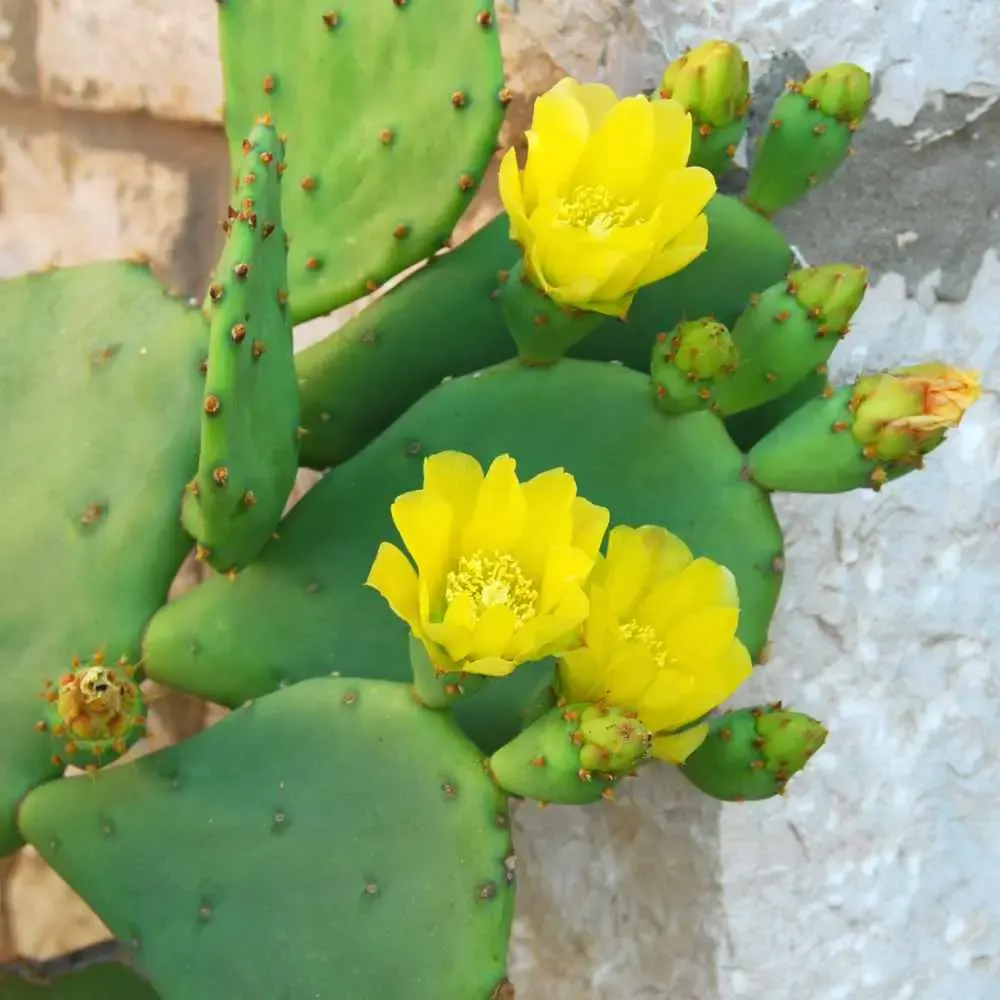
Caring For Prickly Pears:
Are Prickly Pear Cactus easy to take care of? Yes, Prickly pears are very easy care plants. Here’s an “at a glance’ table outlining general care instructions for prickly pear cacti:
| Care Aspect | Description |
|---|---|
| Light | Place the prickly pear cactus in bright to bright indirect sunlight. |
| Temperature | Ideal temperature range is 60°F to 85°F (15°C to 29°C). But hardy down to freezing for brief periods in most cases. |
| Watering | Water deeply when the top 1-2 inches of soil are dry. |
| Soil | Use well-draining cactus or succulent soil mix. |
| Fertilization | Feed with a balanced cactus fertilizer once a month in spring/summer. |
| Pruning | Remove dead or damaged pads with clean, sharp pruners. |
| Propagation | Propagate by planting pads or seeds in well-draining soil. |
| Pests and Diseases | Watch for pests like mealybugs and treat as needed. |
| Winter Care | Reduce watering and keep the cactus in a cooler location. |
| Additional Tips | Handle with care due to spines. Wear gloves when necessary. |
Please note that these instructions are general guidelines that work well for indoor or outdoor gardening. The specific care requirements for your particular prickly pear cactus may vary slightly depending on the species and environmental conditions.
Lets go a bit deeper into the most essential needs of this cacti group.
- Sunlight Requirements: It’s no secret cactus require a LOT of sunlight. They are bred for it. However, during times of unrelenting high heat and drought, your prickly pair may need special care to ensure it is well watered. The paddles may bleach color in extremely hot direct sunlight. That said, a sunny location is a must for cactus. And indoors you will finally have a plant that can stand that strong southern or western exposed window that your other plants can’t handle.
- Soil and Watering: Like all succulent plants, the Optunias will do well in well draining cactus soil and need little watering. For a complete guide to watering succulents read this post.
- Temperature and Hardiness: These are dessert plants and can survive some pretty high heat and nighttime temperature drops. Even to freezing. However, They will die at the extremes if the temperature last too long. You can count on some damage to the paddles and blooms will probably die below freezing. It is possible if the temperatures don’t moderate the paddles may also die. Then all you have are the roots. The roots on optunias are deep, once established, so they may survive to produce new growth in the next growing season. Possibly.
Caring for Prickly Pear Cactus in Different Seasons:
Seasonal care for prickly pear cactus growing outdoors involves making adjustments to watering, temperature, and light exposure to ensure their health and well-being throughout the year. But even indoors you’ll notice the different seasons require some adjustment of your care techniques.
Here are some tips for each season:
Spring:
- Increase watering frequency as the weather warms up and the cactus enters its active growth phase.
- Provide ample sunlight, as spring offers longer daylight hours. Ensure the cactus receives at least six hours of direct sunlight daily.
- Watch out for pests like aphids and scale insects. If infestations occur, treat the affected areas with a suitable insecticide or use natural pest control methods.
Summer:
- Water regularly during hot and dry periods, but avoid overwatering to prevent root rot. Allow the soil to dry out slightly between waterings.
- Provide shade or afternoon protection from intense sun exposure to prevent sunburn. Move potted cacti to a shaded area if necessary.
- Monitor the cactus for signs of dehydration, such as wrinkled or shriveled pads. Increase watering if needed.
Fall:
- Reduce watering as the temperatures start to cool down. Prickly pear cactus enters a dormant phase during the fall and requires less water.
- Gradually decrease the amount of sunlight exposure as winter approaches. This helps the cactus adjust to lower light conditions.
Winter:
- Keep the cactus in a cool location where temperatures remain above freezing. Prickly pear cacti are generally tolerant of mild frost, but prolonged freezing temperatures can damage or kill them.
- Limit watering during winter, as the cactus requires less moisture in its dormant state.
- Protect outdoor cacti from frost by covering them with frost cloths, blankets, or other insulating materials.
Obtunias are hardy in most conditions and for the most part, need no special handling to thrive. The exception is extreme conditions. In extreme heat or cold conditions, monitor the cacti closely and be ready to take necessary precautions to get them through in good health. This may include providing shade, protecting them from frost, or adjusting watering schedules accordingly. Each variety of prickly pear cactus may have specific temperature and water requirements. Do your research on the specific needs of the variety you have and make adjustments accordingly.
How to Propagate Prickly Pears:
There are three methods of propagating prickly pear cactus; seeds, pad cuttings, and grafting techniques. With a little know-how and patience, you can expand your prickly pear cactus collection. Here’s how:
Prickly pear cacti are known for their ability to propagate through vegetative reproduction, with new plants sprouting from pads that fall to the ground. So you may need to do nothing other than dig up a start and transplant it or pot it as you wish.
Seed Propagation:
- If you find the perfect prickly pear you just love and want to propagate it, collect its ripe fruit and extract the seeds by scooping them out or crushing the fruit and separating the seeds.
- Rinse the seeds to remove any pulp or residue.
- Fill a seed tray or small pots with well-draining cactus soil mix.
- Scatter the prickly pear seeds over the soil surface and lightly press them in.
- Mist the soil with water and cover the tray or pots with a clear plastic cover or plastic wrap to create a mini greenhouse effect.
- Place the tray or pots in a warm, bright location with indirect sunlight.
- Keep the soil consistently moist but not soggy.
In a few weeks, you should start to see seedlings emerging. Once they have developed a few sets of true leaves, you can transplant them into individual pots.
Pad Cuttings:
- Select a healthy pad from a mature prickly pear cactus.
- Using clean pruning shears, cut the pad at the joint where it attaches to the main stem.
- Set the pad aside in a warm, dry location for several days to allow the cut end to callus and dry out.
- Fill a pot with well-draining cactus soil mix and make a small hole using your finger or a pencil.
- Place the calloused end of the pad into the hole, ensuring it stands upright.
- Gently backfill the hole with soil and press it down to secure the pad.
- Water the cutting lightly, allowing the soil to dry out between waterings.
- Keep the cutting in a bright location with indirect sunlight.
Over time, the cutting will develop roots and begin to grow new pads, indicating successful propagation.
Grafting:
- Choose a healthy, mature prickly pear cactus to serve as the rootstock.
- Select a desired cultivar or variety to serve as the scion, which will be grafted onto the rootstock.
- Make a clean, slanted cut near the top of the rootstock.
- Make a corresponding slanted cut at the base of the scion, ensuring the cuts match up for a snug fit.
- Place the scion onto the rootstock, aligning the cuts, and secure them together using grafting clips or grafting tape.
- Keep the graft union protected from direct sunlight and excessive moisture.
After a few weeks, the graft should begin to form a bond and show signs of growth.
Remember, successful propagation requires patience, attention to detail, and suitable growing conditions. By exploring different propagation methods, you can experience the joy of growing new prickly pear cacti from seeds, cuttings, or through grafting, and witness the expansion of your cactus collection firsthand.
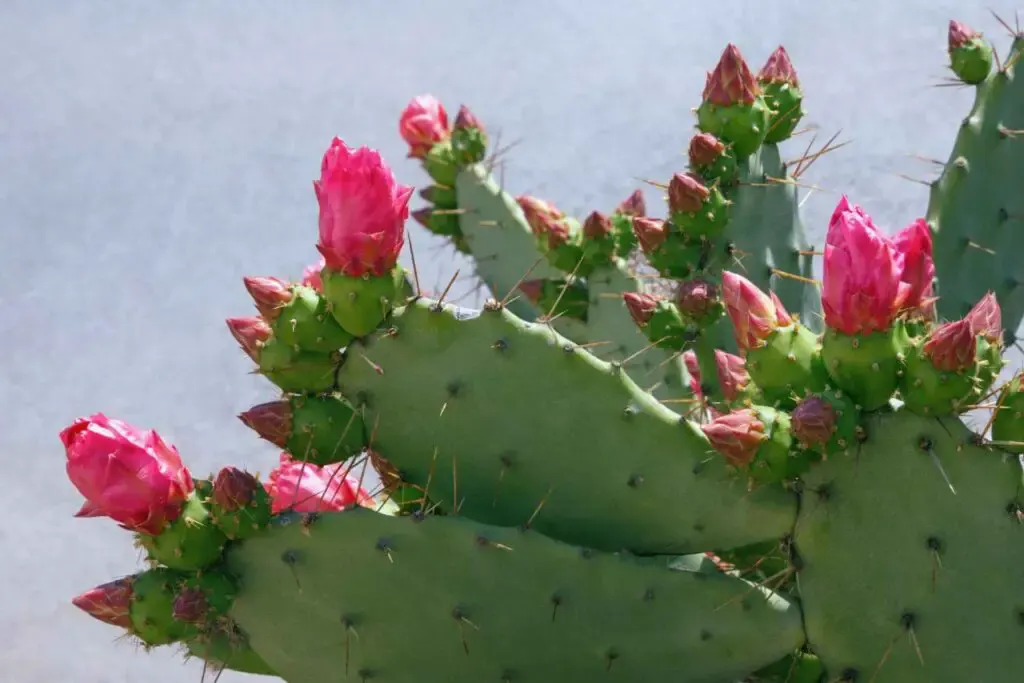
Pruning Prickly Pears:
Pruning and maintenance of prickly pear cacti require care to avoid sharp spines and the irritating nubby glochids. Here are some tips to help you maintain the cactus’s shape, control its size, and handle it safely:
Pruning for Shape and Size Control:
- Use sharp, clean pruning tools such as bypass pruners or loppers.
- When pruning, wear thick, protective gloves, long sleeves, and eye protection to avoid injury from spines or glochids.
- Start by removing any dead, damaged, or diseased pads. Cut them close to the base of the cactus, making clean cuts to prevent jagged edges.
- To control the size of the cactus, selectively prune older or overgrown pads, cutting them back to the desired size or shape. Trim them near a joint or segment to encourage branching.
Handling Spines and Glochids Safely:
When handling prickly pear cacti, wear heavy gloves and long pants and long sleeved shirts.
If you do get stuck, remove the spines or glochids from your skin with adhesive tape or a pair of tweezers to gently lift them away. Avoid using your fingers directly, as this can push the spines deeper or cause them to break off.
If a spine or glochid becomes deeply embedded or causes significant discomfort, seek medical assistance.
Remember to always prioritize safety when working with prickly pear cacti. Take necessary precautions, use appropriate tools and protective gear, and handle the cacti carefully to avoid injuries from spines or glochids.
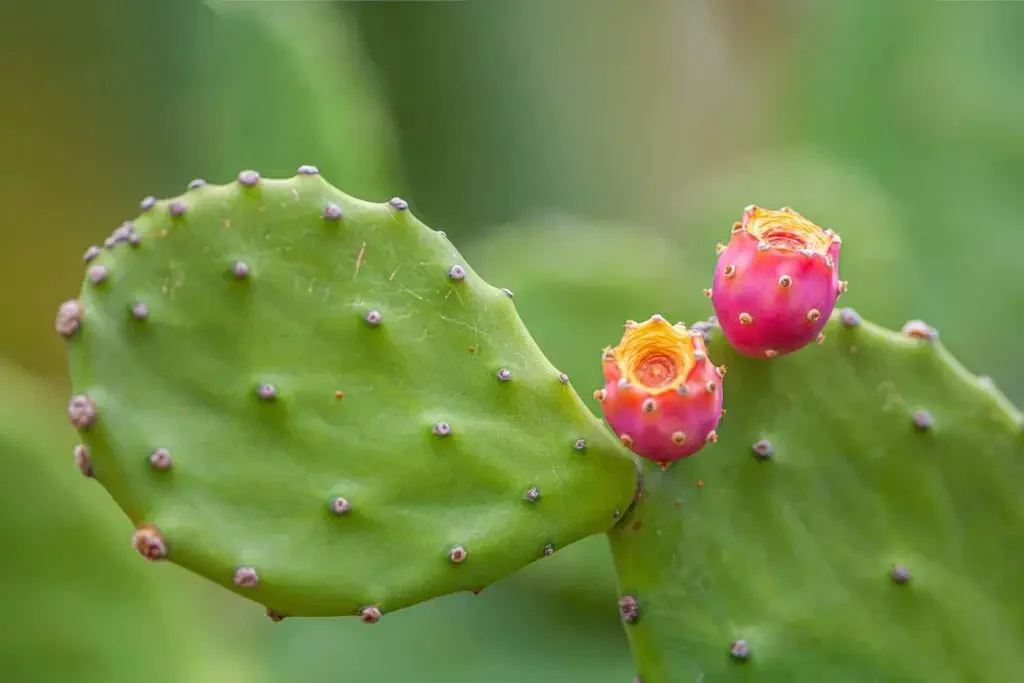
Related Content:
Follow Us:
Find us on YouTube, Instagram , Pinterest and TikTok! We love to Plant chat. We also comment, like and occasionally share your content to our daily stories. We’d love to see your plants. Share your joy in your houseplants. Happy Planting!
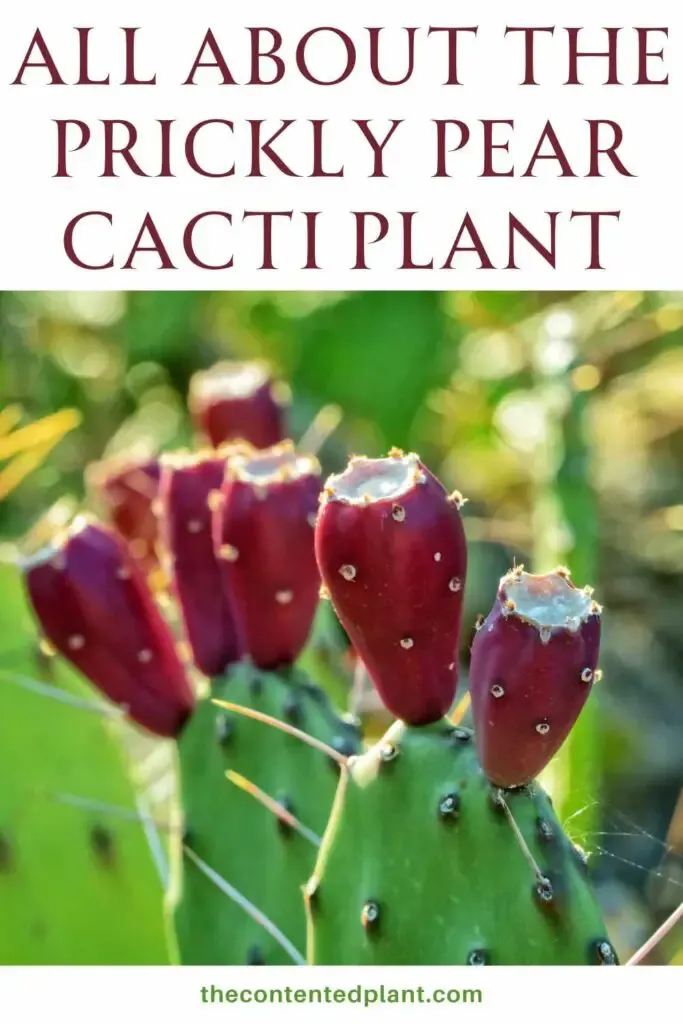

Rebutia Cactus - The Contented Plant
Thursday 13th of July 2023
[…] Prickly Pear Cacti: […]